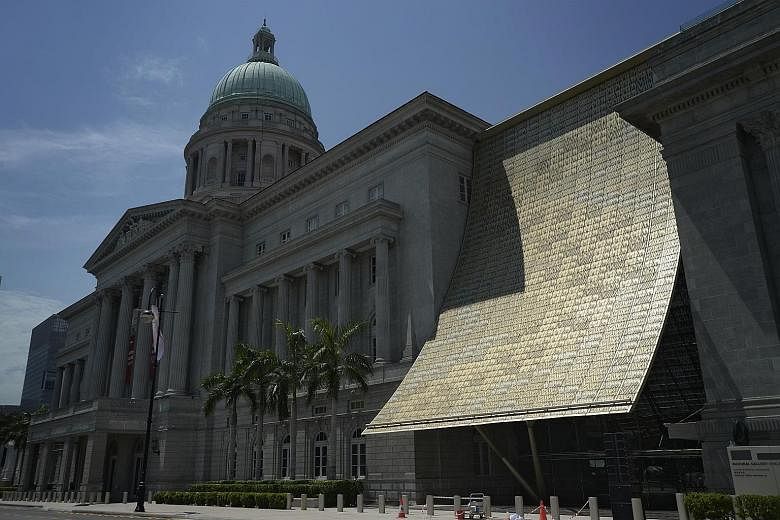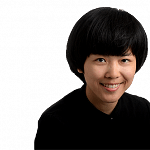From a forest sculpted out of balloons and a 3D interpretation of a painting by Singapore pioneer artist Liu Kang in yarn, to a projection show on the museum's facade and an outdoor food street, National Gallery Singapore is pulling out all the stops to mark its first anniversary later this month.
And it has much to celebrate.
Arts observers, including curators, scholars and artists, say the visual arts institution with the largest public collection of modern art in Singapore and South-east Asia has chalked up significant achievements since its landmark opening - even while there is room for it to grow and improve.
Indonesian artist Ade Darmawan says the museum's extensive collection of art, including key works from the region, has provided a prominent platform to spotlight the rich history and practices of art in South-east Asia.
The exhibitions have also been "strong and well researched", says curator Silke Schmickl, who is with the Institute of Contemporary Arts Singapore at Lasalle College of the Arts. The rigour of the shows, she says, "testifies to the institution's interest in developing a rich, innovative and multi-faceted discourse on modern and contemporary art from the region and beyond".
-
VIEW IT / GALLERY LIGHT TO NIGHT FESTIVAL
-
WHERE: National Gallery Singapore, 1 St Andrew's Road
WHEN: Nov 25 to 27 and Dec 2 to 4, 10 to 3am, galleries close at midnight (Fridays and Saturdays), 10am to 7pm (Sundays)
ADMISSION: Free for the festival and all exhibitions
INFO: www.nationalgallery.sg
The museum's chief executive Chong Siak Ching tells The Straits Times that the feedback it has received in its first year has been largely positive and heartening, and that she is pleased with the turnout.
The museum welcomed its millionth visitor seven months after opening. Some 5,000 people have also joined as members, exceeding the museum's target of 1,200. Members enjoy benefits such as unlimited admission to all exhibitions, and discounts on dining, shopping and ticketed events at the museum.
Its school programme, which includes guided school tours and workshops, has reached about 175,000 participants from primary school to junior college.
Customised tours conducted in sign language and Chinese dialects are also available, and on weekends, music performances take place in the museum's atrium and courtyard spaces.
Professor Ute Meta Bauer, founding director of the NTU Centre for Contemporary Art (CCA) Singapore, says: "To visit the museum over the weekend and see visitors from all age groups and walks of life indicates the appreciation and curiosity of the Singapore audience. This is a major achievement, which should encourage and inspire art institutions here, including the NTU CCA Singapore, to develop their own profiles as being distinct from the museum."
-
Light To Night festival highlights
-
FESTIVAL FOOD STREET
Food stalls such as Momolato, selling gelato and popsicles, and Owl Cafe, selling Singapore delights, will set up along St Andrew's Road. Where: St Andrew's Road When: Nov 25 and 26, Dec 2 and 3, 5 to 11.30pm
FACADE SHOW
A dazzling light show by Australian creative studio Spinifex Group, projected onto the museum's facade. Where: National Gallery Singapore facade, 1 St Andrew's Road When: Nov 25 and 26 and Dec 2 and 3, from 8pm
MOVIE IN THE CIVIC DISTRICT
An outdoor screening of Royston Tan's film, Homecoming (2016). Where: The Padang When: Nov 26, 9pm
MUSIC PERFORMANCE BY NATHAN HARTONO
Sing! China finalist Nathan Hartono will perform with music producer Evan Low. Where: Padang Atrium, National Gallery Singapore When: Dec 2, 9pm
Still, there is room for the museum to improve.
A common feedback from visitors soon after the museum opened was that more signs were needed to help them find their way around the building. The museum has since put up more signs and has also trained staff to be proactive in offering directions, says its director Eugene Tan.
The museum has also increased the font size for its wall labels "substantially", he says, following persistent requests from visitors to improve the visibility of the text panels.
Dr Simon Soon, a University of Malaya senior lecturer who has used the museum's resource centre several times for his art research, says the museum should not rely too much on blockbuster shows that are based on collaborations with other international institutions.
The museum's ongoing exhibition, Artist And Empire: (En)countering Colonial Legacies, is coorganised with Tate Britain, and an earlier exhibition, Reframing Modernism, was co-organised with Centre Pompidou, Paris.
Dr Soon says: "There were smaller shows such as A Fact Has No Appearance, which suggest that research that slowly builds into an exhibition can be a lot more meaningful than the spectacle of a large-scale exhibition."
Critical response to A Fact Has No Appearance has been warm and institutions in the region have requested for it to travel to their exhibition spaces.
The museum's role, however, goes beyond staging exhibitions, says Prof Bauer. Fostering longterm research collaborations both in Singapore and abroad is a key role it needs to play, she adds, and it is critical that the museum "does not enter into high-profile partnerships with only institutions from the West, but also seeks to strengthen the network across the region".
"There is urgency, necessity and curiosity in the region to engage with its diverse art histories, and the museum can be a catalyst," she says.
The museum's programmes could also be beefed up, say observers.
Its film programme, for example, could be more ambitious and dedicated to experimental films, video art and documentaries on art and architecture, says Lasalle's Ms Schmickl.
Avid museumgoer Jean Tsai, a marketing consultant in her 50s, hopes the museum will adopt a more interdisciplinary approach to its programmes and explore "expressions of modernity in Southeast Asian architecture, music, cuisine and fashion, intertwined with fine art" to spur holistic appreciation of the arts and draw new and repeat visitors.
The museum's director, Mr Tan, says it is looking to expand its film programme and is also working on furthering research and curatorial collaborations in the region.
It is a partner institution, along with Institute of Technology Bandung, in a research project developed by The Power Institute Foundation for Art and Visual Culture at the University of Sydney. The project tracks the development of artists, arts groups, ideas and works that shaped the art world of Southeast Asia after World War II.
The museum is also working on an exhibition that began as a research project with The National Museum of Modern Art, Tokyo and the National Museum of Modern and Contemporary Art in South Korea. The jointly curated show is scheduled to open here in 2019.
It is also collaborating with artists to create new works that can be experienced only with its mobile application. At present, the app allows visitors to explore the museum and its works.
Ms Chong says it has been working on reducing the admission fee for visitors from South-east Asia too.
"We do realise that the South- east Asian community is a very important stakeholder for us. The engagement with our peer institutions in South-east Asian countries has been strong and they have been very supportive, loaning some of their key works to us for exhibitions," she says.
As the museum continues to work on revising the admission fee, she says she has also encouraged the embassies of South-east Asian countries to celebrate their National Day at the museum so they can open the space to their countrymen.
Dr Soon says: "A ticket at $20 is incredibly steep because of currency exchange. A free or subsidised entrance fee can go a long way in encouraging audiences from other parts of South-east Asia to take interest and ownership of our modern art history."


